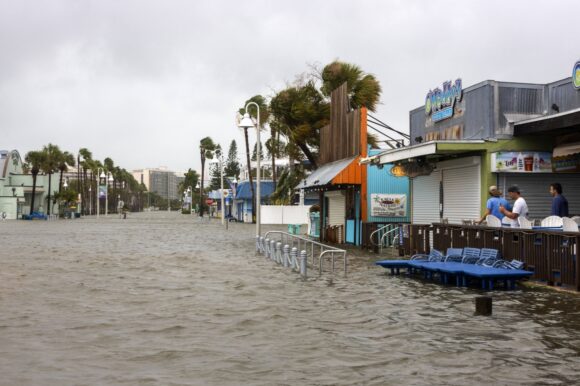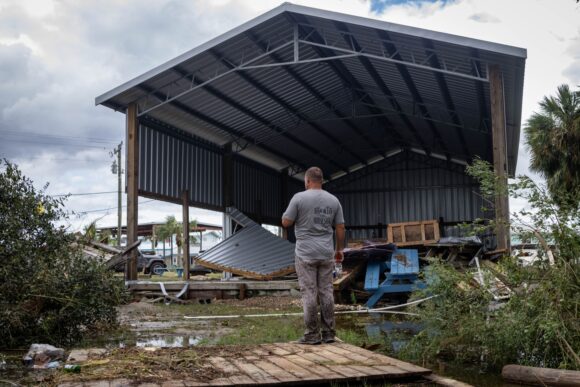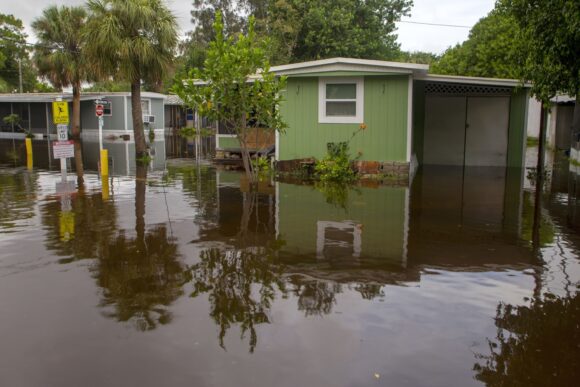Hurricane Idalia unleashed its fury on northwest Florida on Wednesday morning, landing in a sparsely populated area with winds of 125 miles (201 kilometers) per hour and 9 feet of storm surge. Although the urban conglomeration of Tampa-St. Petersburg was spared a direct hit, Idalia still brought upwards of 4 feet of storm surge to Tampa Bay. Videos on social media showed water threatening homes and flooded roads as the storm lashed the region before barreling into Georgia and South Carolina.
The low-lying stretch of Florida’s Gulf Coast is at risk from increasingly intense storms fueled by global warming. And it’s exposed in another sense: Although one of the main hurricane hazards is flooding caused by storm surge or heavy rains, the vast majority of properties there lack federal flood insurance, according to an analysis of Federal Emergency Management Agency data by reinsurer Gallagher Re.
One of the most concerning aspects of #Idalia is storm surge. Current NHC forecast of 10-15′ of coastal water inundation would affect an area with lower population, but also low NFIP flood insurance take-up.
Translation: A lot of uninsured exposure for water-related damage. pic.twitter.com/6s2FzPXru8
— Steve Bowen (@SteveBowenWx) August 29, 2023
The gap highlights the problem of under-insurance in a state that’s the nation’s fastest growing and also one of the most vulnerable to impacts of climate change, and where the insurance industry is already under strain.
The share of federally flood-insured properties in Taylor County, where the storm made landfall, is only 5.4%. In Hillsborough County, home to Tampa, it’s 20%. But that still leaves four out of five properties unprotected. Only 18% of Floridians have flood insurance, according to the Insurance Information Institute.
“Many of those living in Tampa Bay are going to be exposed,” said Charles Nyce, an associate professor of risk management and insurance at Florida State University, as the storm approached. If Idalia had tracked farther east, the potential for flood damage would have been higher.

Read More: Property Owners Ignore Climate Risk Amid Insurance Meltdown
There are various reasons why people are underinsured. Many can’t afford flood insurance. Others may not be aware that their homeowner’s insurance doesn’t cover flooding. Still others may feel that if they’re not required to buy flood insurance, they don’t need to.
“Folks say that they’re surprised to learn that the flood damage that they had sustained was not in fact covered by the policy,” said Steve Bowen, chief science officer at reinsurer Gallagher. “There’s an education gap.”
The state of Florida offers property insurance through a nonprofit called Citizens Property Insurance Corp. The insurer of last resort, it is now the state’s biggest provider, after many private insurers failed or retreated from Florida. It will likely bear the brunt of the losses from Idalia, although early estimates put them much lower than those from last year’s Hurricane Ian, Florida’s most costly hurricane. Citizens doesn’t offer flood insurance, which is sold largely through the federal National Flood Insurance Program.
Last December, Florida Governor Ron DeSantis signed a bill to stabilize the state insurance industry. It included a provision requiring Citizens to mandate flood coverage. Policyholders in designated hazard areas must begin to take on flood insurance, whether from NFIP or a private insurer. Starting in January, covered residences that cost $600,000 or more to replace must carry it. That threshold declines by $100,000 a year until 2027, when all covered residences, including tenant-occupied buildings, must carry flood coverage.

On the ground after a storm, adjusters have to decide what caused damage to a structure: wind or water. If a structure is both wind- and water-insured, it makes a contentious — and sometimes litigious — process slightly less so. “Having both guaranteed protection with wind and water, I think the state just felt that was a safer approach, to ensure that everybody was going to be a bit more protected,” said Gallagher’s Bowen.
Bowen said people need to be equipped with information “to understand that if they are in a potentially risky area, and they choose not to purchase [flood insurance], that that’s a decision they’re making on their own. And that’s unfortunately a risk that oftentimes leads to a lot of regret.”
Florida has lured new arrivals seeking to escape high taxes and cold winters elsewhere. But they’re often moving to danger zones. Across the US, the most flood-prone counties experienced a net influx of about 400,000 people in 2021 and 2022, real estate brokerage Redfin Corp. found in a recent analysis.
Read More: Americans Are Moving Toward Climate Danger in Search of Cheaper Homes
In the Tampa-St. Petersburg-Clearwater area, the number of residents has jumped about 4% in four years to 3.3 million in 2022, according to Federal Reserve Bank of St. Louis data. That growth has fueled a property boom, with prices for single-family homes having almost doubled to $465,000, according to Redfin.
“This follows the national trend of more people living in harm’s way of catastrophes,” said Mark Friedlander, a spokesman for the Insurance Information Institute.
–With assistance from Felipe Marques.
Top Photo: A flooded mobile home park in the Gandy neighborhood of St. Petersburg, Florida, on Wednesday.
Was this article valuable?
Here are more articles you may enjoy.


 Palantir Poaching Suit Called ‘Scare’ Tactic by Ex-Employees
Palantir Poaching Suit Called ‘Scare’ Tactic by Ex-Employees  US Lawmaker Unveils Bill Requiring Manual Car-Door Releases
US Lawmaker Unveils Bill Requiring Manual Car-Door Releases  Tesla, EEOC Plan Talks to Settle Factory Racism Suit
Tesla, EEOC Plan Talks to Settle Factory Racism Suit  Surging Oil Tanker Insurance Points to Growing Black Sea Chaos
Surging Oil Tanker Insurance Points to Growing Black Sea Chaos 